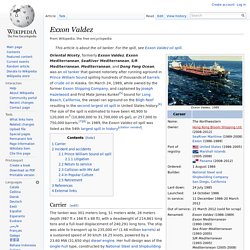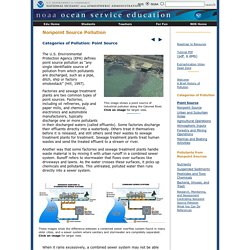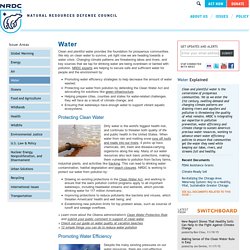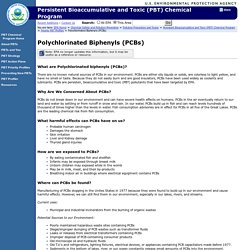

Ocean chemical pollution chart. Exxon Valdez. Carrier[edit] Incident and accidents[edit] Prince William Sound oil spill[edit] At the time of the spill, Exxon Valdez was employed to transport crude oil from the Alyeska consortium's pipeline terminal in Valdez, Alaska, to the lower 48 states of the United States.

At the time it ran aground, the vessel was carrying about 201,000 m³ (53.1 million gallons) of oil. After the spill, the vessel was towed to San Diego, arriving on June 10, 1989, and repairs were started on June 30, 1989. Litigation[edit] Litigation was filed on behalf of 38,000 litigants. Return to service[edit] Polychlorinated biphenyl. Chemical structure of PCBs.

The possible positions of chlorine atoms on the benzene rings are denoted by numbers assigned to the carbon atoms. PCB warning label on a power transformer known to contain PCBs. A polychlorinated biphenyl (PCB; CAS number 1336-36-3 ) is a synthetic organic chemical compound of chlorine attached to biphenyl, which is a molecule composed of two benzene rings.
There are 209 configurations of organochlorides with 1 to 10 chlorine atoms. The chemical formula for a PCB is C12H10-xClx. 130 of the different PCB arrangements and orientations are used commercially.[1] Polychlorinated biphenyls were widely used as dielectric and coolant fluids, this means that they reduce the chance of fires occurring in electrical fields in such a manner that is safe for electricians to work with. Concerns about the toxicity of PCBs are largely based on compounds within this group that share a structural similarity and toxic mode of action with dioxin. Alternative names[edit] MDN: The Mercury Problem. For thousands of years, civilizations ancient and modern have found mercury to be useful in many ways.

Worldwide industrial use of mercury in mining and manufacturing processes, as well as emission during power generation, has greatly increased concentrations of mercury in the environment. Unfortunately, appreciation of mercury 's adverse health effects on humans is only recent. Currently, U. S. health concerns do not center on exposure to elemental mercury, but rather on very low methyl-mercury contamination in fish. Mercury persists in the environment. Mercury is in a class of chemicals called persistent bioaccumulative toxins.
Mercury accumulates in the food chain. Chemical pollution - Marine pollution. The deep ocean is subject to chemical pollution from a variety of sources, as shown most dramatically following the blow out at the Macondo oil well at around 1500 m depth in 2010.

As well as oil pollution following disasters, the deep ocean receives chemical input from a wide range of sources including run-off from land, waste disposal (litter, sewage, radioactive waste, mine/dredge tailings), pollution from shipping, routine oil drilling (from drilling mud, cuttings and produced water) and inadvertent dumping (shipwrecks). The Macondo / Deepwater Horizon blow out in the Gulf of Mexico (image from the United States Coast Guard). With increased human use of the open ocean for transport, mineral extraction and disposal, almost all of these sources of chemical pollution are increasing, resulting in greater and greater impact to the deep ocean and its ecosystems. Life in the deep sea may be less resilient to its effects. Deepwater oil drilling impact in the NE Atlantic.
Toxic Pollution. Chemical Pollution. S National Ocean Service Education: Nonpoint Source Pollution. The U.S.

Environmental Protection Agency (EPA) defines point source pollution as “any single identifiable source of pollution from which pollutants are discharged, such as a pipe, ditch, ship or factory smokestack” (Hill, 1997). Ocean Health Index. Water Pollution Facts, Effects of Water Pollution, Clean Water Act. Clean and plentiful water provides the foundation for prosperous communities.

We rely on clean water to survive, yet right now we are heading towards a water crisis. Changing climate patterns are threatening lakes and rivers, and key sources that we tap for drinking water are being overdrawn or tainted with pollution. NRDC experts are helping to secure safe and sufficient water for people and the environment by: Promoting water efficiency strategies to help decrease the amount of water wasted;Protecting our water from pollution by defending the Clean Water Act and advocating for solutions like green infrastructure;Helping prepare cities, counties and states for water-related challenges they will face as a result of climate change; andEnsuring that waterways have enough water to support vibrant aquatic ecosystems.
Protecting Clean Water Dirty water is the world's biggest health risk, and continues to threaten both quality of life and public health in the United States. Ocean Briefing Book. Mercury Causes Chronic Disease. The association of mercury to chronic diseases is well documented in the didactic scientific literature.

The search for the association between mercury and cardiovascular disease reveals 358 scientific papers exemplifying the relationship; between mercury and cancer we find 643 scientific papers. The association of mercury with neurodegenerative diseases is the most significant, with the references numbering 1,445.[1] If mercury is the primary source of autism, it may befor Alzheimer’s disease and diabetes as well asa long list of other neurological disorders.
Levels of mercury currently regarded as safe for adults could be impairing brain function without doctors and health officials diagnosing acute or chronic mercury poisoning. Mercury could be reducing the mental performance of millions if not billions of people worldwide and medical experts are just not seeing it. Mercury poisoning. Symptoms typically include sensory impairment (vision, hearing, speech), disturbed sensation and a lack of coordination.

The type and degree of symptoms exhibited depend upon the individual toxin, the dose, and the method and duration of exposure. Signs and symptoms[edit] Common symptoms of mercury poisoning include peripheral neuropathy (presenting as paresthesia or itching, burning or pain), skin discoloration (pink cheeks, fingertips and toes), swelling, and desquamation (shedding or peeling of skin). Mercury irreversibly inhibits selenium-dependent enzymes (see below) and may also inactivate S-adenosyl-methionine, which is necessary for catecholamine catabolism by catechol-o-methyl transferase. Due to the body's inability to degrade catecholamines (e.g. epinephrine), a person suffering from mercury poisoning may experience profuse sweating, tachycardia (persistently faster-than-normal heart beat), increased salivation, and hypertension (high blood pressure).
Stephen Palumbi: Following the mercury trail. Oceanic Coal Pollution, Epic Rate. Catalyst: Plastic Oceans - ABC TV Science. Persistent Bioaccumulative and Toxic (PBT) Chemical Program. Note: EPA no longer updates this information, but it may be useful as a reference or resource.

Scientific Facts on PCBs Polychlorinated biphenyls. Context - Polychlorinated biphenyls (PCBs) are a group of man-made compounds that were widely used in the past, mainly in electrical equipment, but which were banned at the end of the 1970s in many countries because of environmental concerns.

Because these compounds are generally very stable, they remain present in the environment today. What are the health risks associated with PCBs? This Digest is a faithful summary of the leading scientific consensus report produced in 2003 by the International Programme on Chemical Safety (IPCS) of the World Health Organization (WHO): "Polychlorinated biphenyls : Human health aspects. Concise international chemical assessment document 55" Learn more... Source document:IPCS - WHO (2003)Summary & Details: GreenFacts 1.